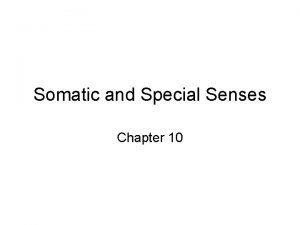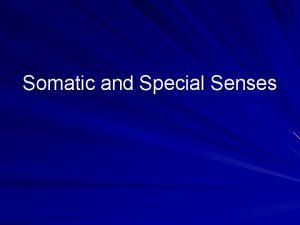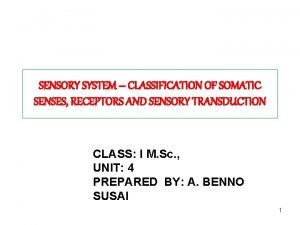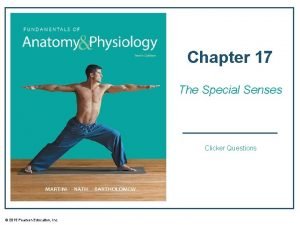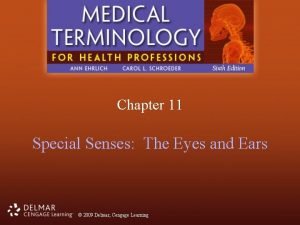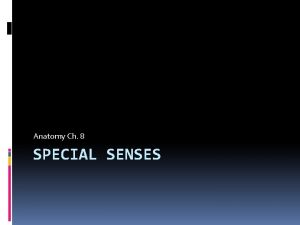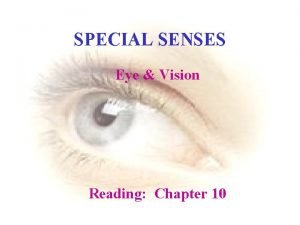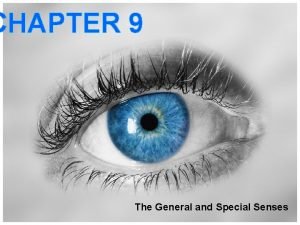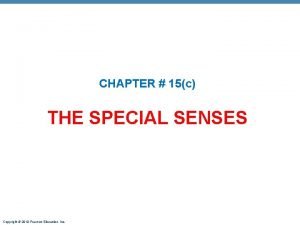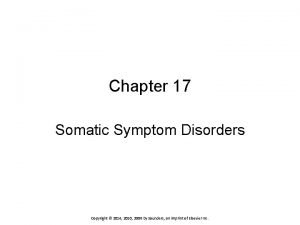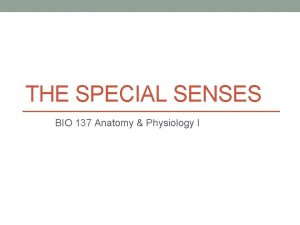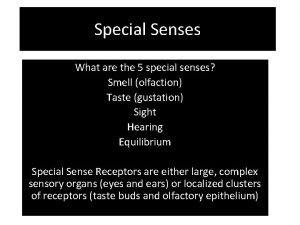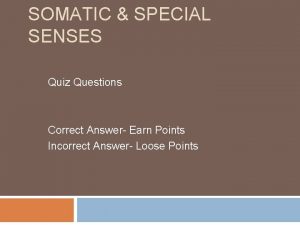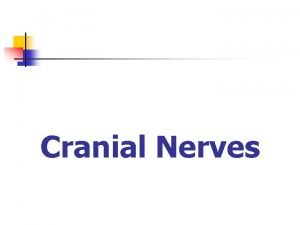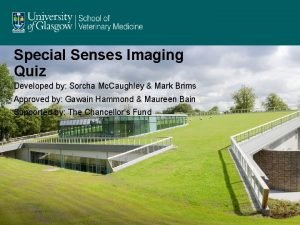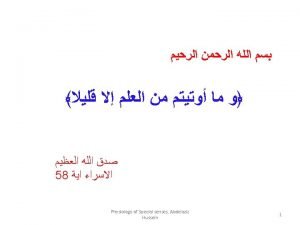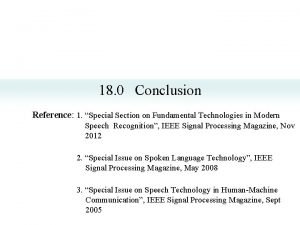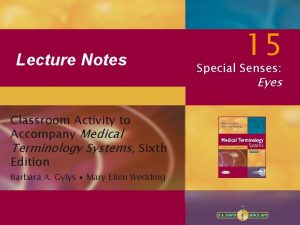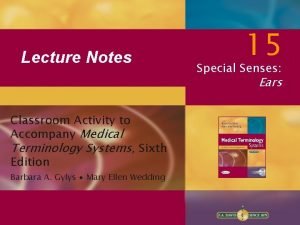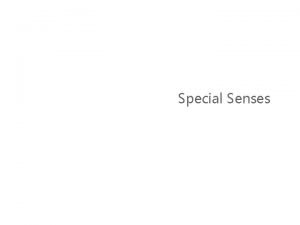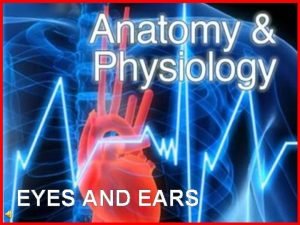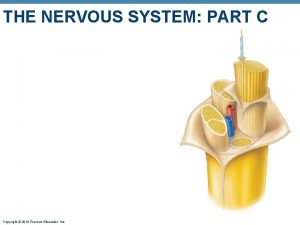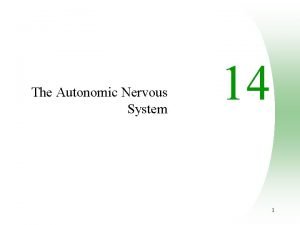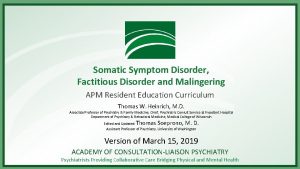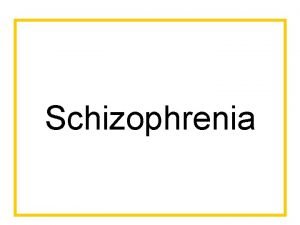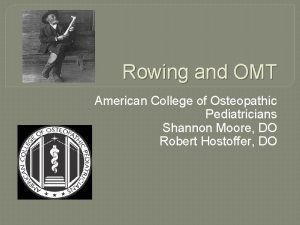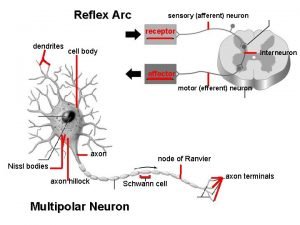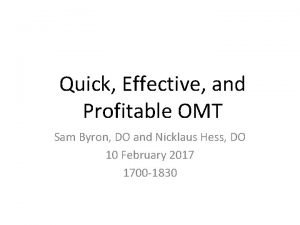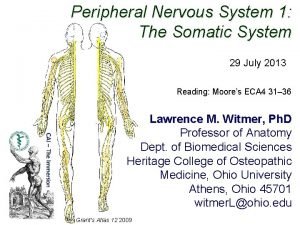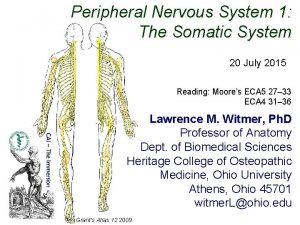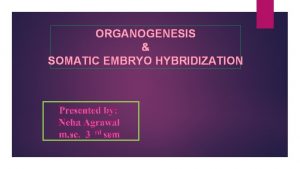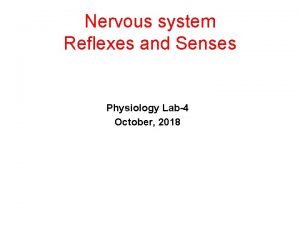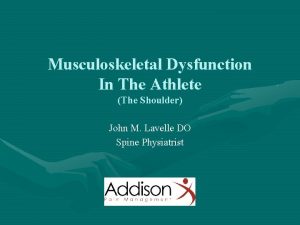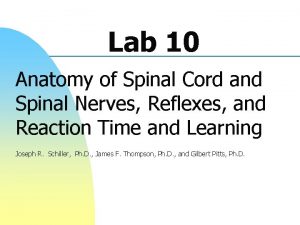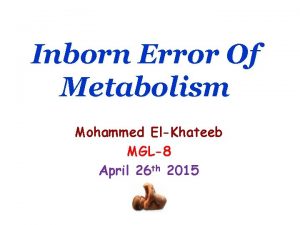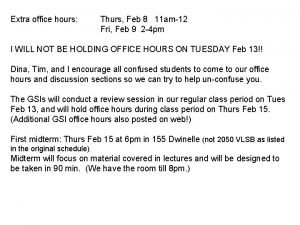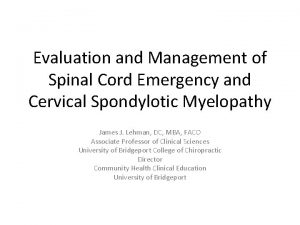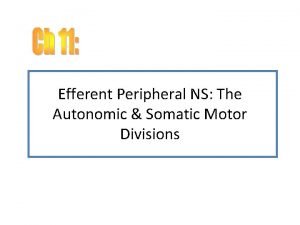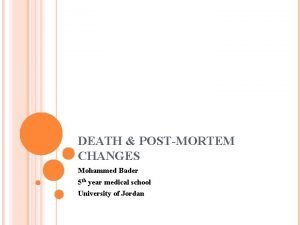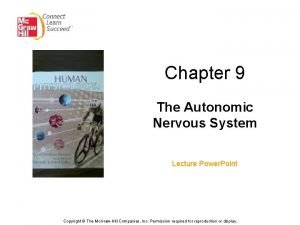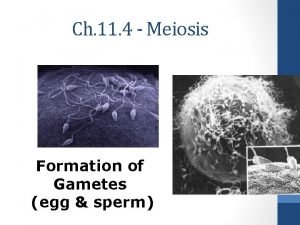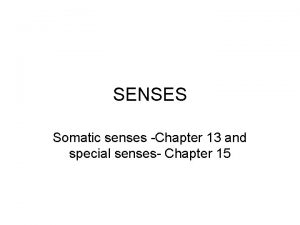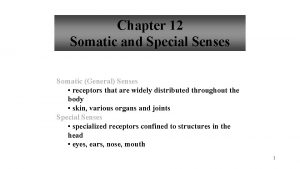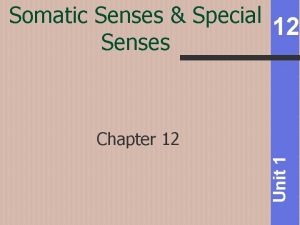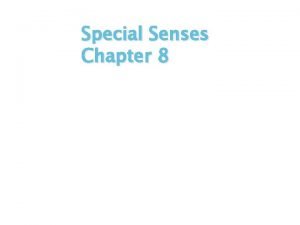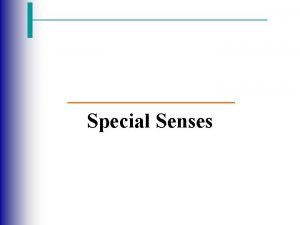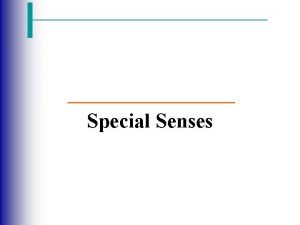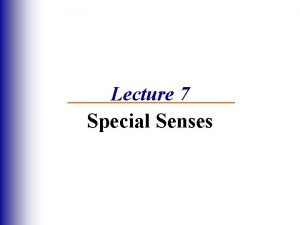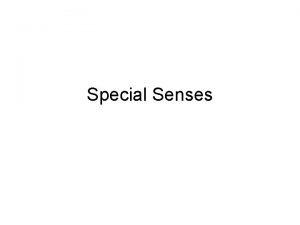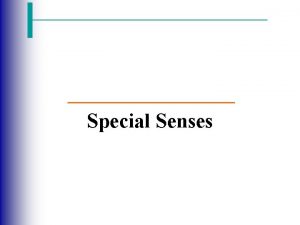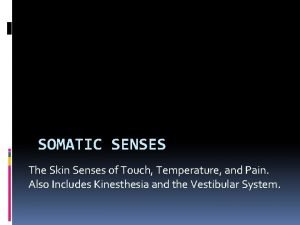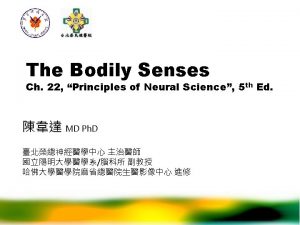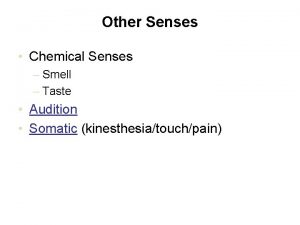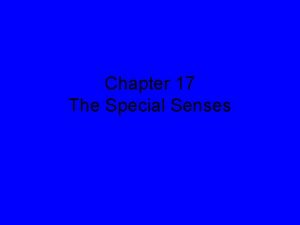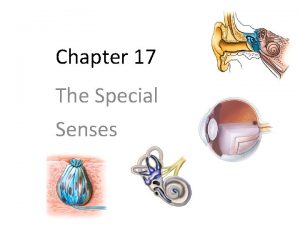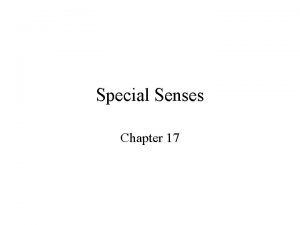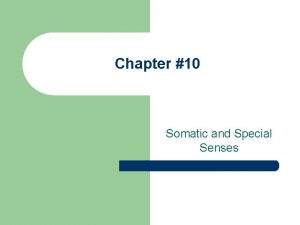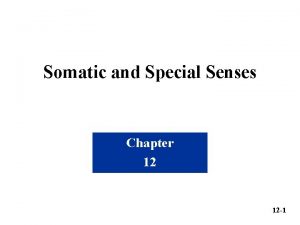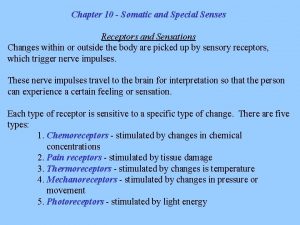Somatic Senses Special Senses Chapter 12 Special Senses




















































- Slides: 52

Somatic Senses & Special Senses Chapter 12

Special Senses (Special Location) � Smell (olfaction) � taste (gustation) � vision � balance � hearing

General Senses (Somatic & Visceral) �Temperature �Touch �Pressure �Vibration �Proprioception �Pain �Internal organ conditions

Definition of Sensation � � 1. 2. 3. 4. Conscious or subconscious awareness of change in external or internal environment Requires: Stimulus Sensory receptor Neural pathway Brain region for integration

Characteristics � Perception- conscious awareness ◦ Cerebral cortex function � Adaptation- decreased receptor response with prolonged stimulation Þdecreased perception Adaptation speed varies with receptor

Structural Types � Free nerve endings- ◦ pain, thermal, tickle, itch & some touch receptors � Encapsulated nerve endings ◦ Touch pressure & vibration � Specialized cells: ◦ e. g. hair cells in inner ear

Receptor Mechanisms �Mechanoreceptors- ◦ cell deformation, stretching or bending �Thermoreceptors- temperature �Nociceptors – pain �Photoreceptors- light �Chemoreceptors- chemicals ◦ Taste, smell, body fluid content

Somatic Senses � Receptors- distributed unevenly � In skin, mucous membranes, muscles, tendons, & joints � Dense receptors concentration in fingertips, lips & tip of tongue

Tactile sensations � Touch, pressure, vibration, itch & tickle � Itch & tickle – free nerve endings � encapsulated mechanoreceptors

Figure 12. 1

Itch & tickle � Itch- chemical stimulation of free nerve endings ◦ Bradykinin from inflammation response � Tickle- from free nerve endings & lamellated corpuscles ◦ Requires someone else- blocked by signals from cerebellum

Thermal Sensations �Two kinds of thermoreceptors�Between 10 o & 40 o C - cold ◦ Located in epidermis �Between 32 o & 48 o C – warm ◦ located in dermis �Outside these ranges – nociceptors �Both adapt rapidly but continue slow signals during prolonged stimulus

Pain Sensations �Nociceptors- free nerve endings �Found in every tissue but brain �Very little adaptation �Fast pain= acute, sharp pain (0. 1 sec) ◦ not felt in deep tissues and well localized �Slow pain- slow starting & increases ◦ Chronic, burning, aching or throbbing sensation

Visceral pain location displaced to surface = referred pain

Proprioception �Head and limb position & motion ◦ Located in muscles (muscle spindles), tendons (tendon organs), in & around synovial joints (joint kinesthetic receptors) �Kinesthesia= perception of movements �Inner ear (hair cells)- head position �Tracts to primary sensory area of cerebral cortex & cerebellum �Slow & slight adaptation

Figure 10. 13

Smell. Olfactory Pathway

Smell. Olfaction

Stimulation of Receptors �Genetic evidence- 100’s of primary odors �Binding of chemical stimulates nerve �Recognition of 10, 000 odors from combination of primary receptor input �Rapid adaptation by ~50% in 1 sec.

Taste- Gustatory Sensation � 5 primary tastes: salt, sweet, sour, bitter & umami �Perception of what we call taste includes olfactory input �Receptors in taste buds (~10, 000)

Taste. Gustatory Structures

Papillae Details

Figure 12. 4 c

Stimulation �Tastant- dissolved in saliva �Receptors respond to more than one tastant �Release neural transmitter to primary gustatory neuron �Tastes arise from mix of input form various areas

Gustatory Pathway �Facial & glossopharyngeal-tongue �vagus- pharynx & epiglottis �to medulla oblongata � thalamus � primary gustatory area◦ consciousness �Also medulla limbic system

Vision- Eyes �Accessory structures�eye brows, eyelashes- protection �eye lids- protection & lubrication (blinking) �extrinsic muscles- moving eyeball ◦ Superior Rectus, inferior rectus, lateral rectus, medial rectus, superior oblique, inferior oblique

Lacrimal Apparatus (Tear Production)

Layers of the Eyeball

Figure 12. 7

Back of the Eye Layers

Refraction of Light �Light rays bend on passing from medium of one density to another of different density = refraction � 75% occurs at cornea �Lens- focuses light on the retina �Image is inverted but brain adjusts & interprets distance and size

Figure 12. 9 a

Figure 12. 9 b

Figure 12. 9 c

Figure 12. 10

Other visual controls �Constriction of pupil- ◦ autonomic reflex to center light on lens �Convergence- midline eyes rotate toward ◦ as object nears it is necessary to maintain focus on single object for binocular vision �Photoreceptors: light neural signal ◦ light is absorbed by a photopigment (rhodpsin) which splits into opsin & retinal

Visual Pathway

Detecting Diseases of the Retina Webster, John G. , Bioinstrumentation, Wiley, Ch 7, 2004.

• Mirror • Examiner’s eyes • Lamp • Inverted image of eye Detecting Diseases of the Retina (2) • Condensing lens • Patient’s eye Webster, John G. , Bioinstrumentation, Wiley, Ch 7, 2004.

Major Ear Structures

Details of Inner Ear Structure

Spiral Organ Detail

Physiology of Hearing

Auditory Pathway � Cochlear neurons end on same side in medulla � Through midbrain to thalamus � Auditory Cortex on Temporal lobe ◦ Receives input from both ears

Hearing Aids vs. Cochlear Implants Courtesy of Zounds Corporation In the ear (ITE) and behind the ear (BTE) hearing aids amplify sounds (Above). Cochlear implants place electrodes directly into the cochlea replacing the operation of the hair-tonerve connections to the brain.

Physiology of Equilibrium � Equilibrium in part monitored in inner earvestibular system � Static equilibrium- position relative to gravity � Dynamic equilibrium- position in response to head movement

Static Equillibrium

Dynamic Equilibrium

Figure 12. 15 b

Figure 12. 16 b

Equilibrium Pathways � Axons from vestibular branch � medulla or cerebellum � Medulla motor for eye & head & neck � spinal cord tracts for adjusting muscle tone & postural muscles

Wrap Up!! What did we learn? � Somatic vs. Special Senses � Somatic receptors (e. g. baroreceptors, etc. ) � Special Senses ◦ ◦ Gustatory Olfactory Optic Auditory � Special Senses Disorders & Treatments � This content fulfills some of the requirements of the following TCOs: ◦ 1, 3, 4, 5, 6 & 7
 Thermoreceptors
Thermoreceptors What is the difference between somatic and special senses
What is the difference between somatic and special senses Somatic and special senses
Somatic and special senses General senses vs special senses
General senses vs special senses Classification of sensory system
Classification of sensory system Chapter 17 special senses answer key
Chapter 17 special senses answer key Medical terminology chapter 11 learning exercises answers
Medical terminology chapter 11 learning exercises answers Anatomy and physiology chapter 8 special senses
Anatomy and physiology chapter 8 special senses Eye anatomy
Eye anatomy Chapter 10 special senses
Chapter 10 special senses The general and special senses chapter 9
The general and special senses chapter 9 Olfactory receptor cells
Olfactory receptor cells Chapter 15 special senses
Chapter 15 special senses Types of somatic disorder
Types of somatic disorder Chapter 17 somatic symptom disorders
Chapter 17 somatic symptom disorders Bio 137
Bio 137 Five basic taste sensations
Five basic taste sensations The cones of the retina are coursera quiz answers
The cones of the retina are coursera quiz answers Cranial nerve mnemonic
Cranial nerve mnemonic Special senses quiz
Special senses quiz Palpebral fissure
Palpebral fissure Signal conclusion
Signal conclusion Building vocabulary activity: the special senses
Building vocabulary activity: the special senses Building vocabulary activity: the special senses
Building vocabulary activity: the special senses Houses the receptors for hearing
Houses the receptors for hearing General and special senses
General and special senses Special senses the eyes and ears
Special senses the eyes and ears Spinal cord diagram
Spinal cord diagram Somatic reflex vs visceral reflex
Somatic reflex vs visceral reflex Somatization disorder dsm 5
Somatization disorder dsm 5 Somatic nervous system (sns)
Somatic nervous system (sns) Somatic motor cortex
Somatic motor cortex Haploid vs diploid venn diagram
Haploid vs diploid venn diagram Looseness of association
Looseness of association Rib raising omt
Rib raising omt Site of somatic motor neuron cell bodies
Site of somatic motor neuron cell bodies Rib somatic dysfunction
Rib somatic dysfunction Visceral afferent vs efferent
Visceral afferent vs efferent Erb palsy
Erb palsy Process of somatic embryogenesis
Process of somatic embryogenesis Somatic reflex
Somatic reflex Rib somatic dysfunction
Rib somatic dysfunction Why dna is more stable than rna?
Why dna is more stable than rna? Somatic motor neuron
Somatic motor neuron Organic acidemia
Organic acidemia Affinity maturation somatic hypermutation
Affinity maturation somatic hypermutation Lhermitte's sign
Lhermitte's sign Somatic motor neuron
Somatic motor neuron Factitious disorder
Factitious disorder Somatic death
Somatic death Preganglionic parasympathetic fibres
Preganglionic parasympathetic fibres Sensory modality examples
Sensory modality examples Gamete vs somatic cell
Gamete vs somatic cell
